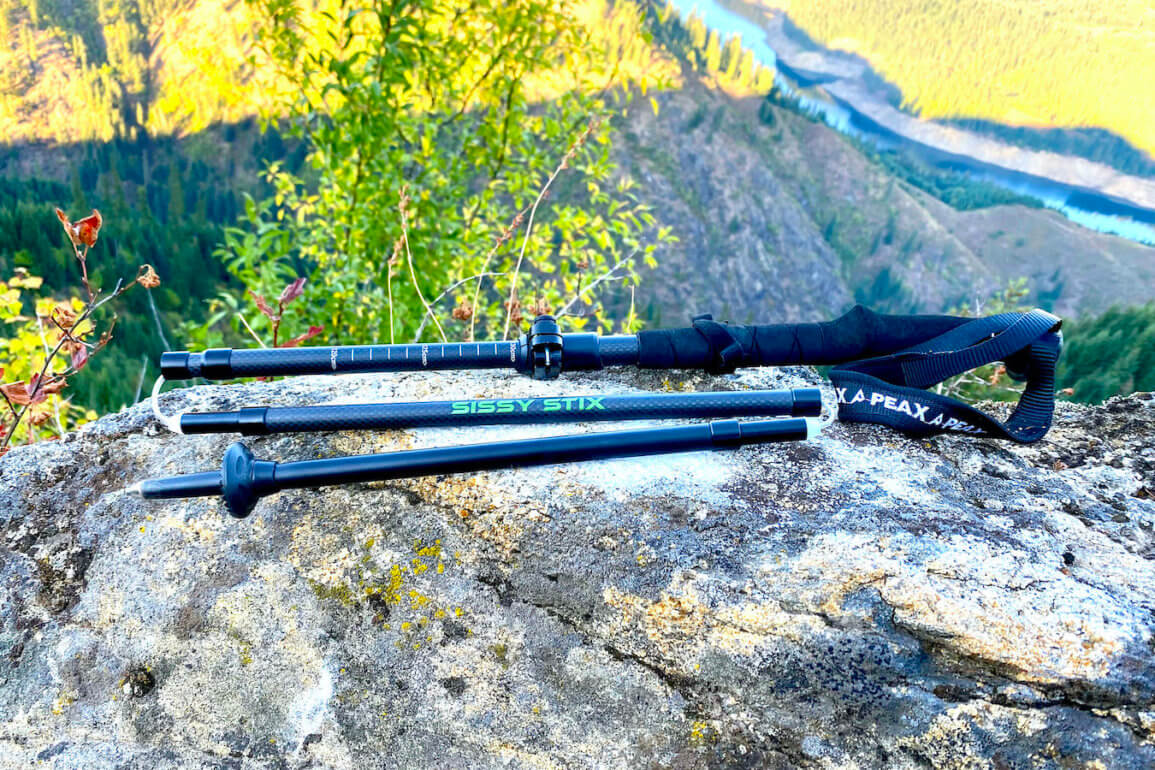The PEAX Backcountry Z Sissy Stix are folding z-style trekking poles designed for rugged backcountry hunting. They’re particularly compact and packable, which is their most important advantage over other hunting trekking poles.
In fact, after using longer, less-packable trekking poles that kept getting hung up on brush and low branches when stowed in my hunting pack, I got fed up and bought the Backcountry Z Sissy Stix. And I’m glad I did.
After testing the PEAX Backcountry Z trekking poles during an Idaho elk archery hunt, this what I learned:
My Problem with Telescoping Trekking Poles
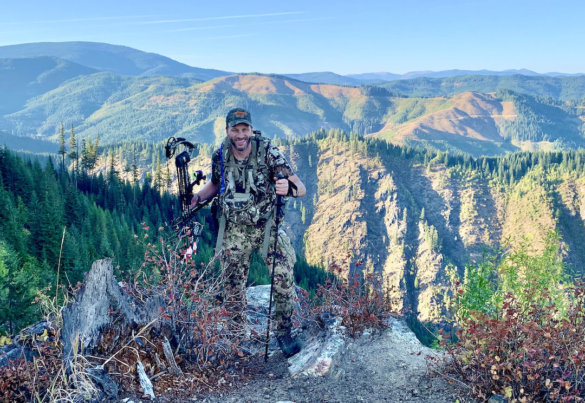
Even though I only hunted with the Sissy Stix in mixed Idaho terrain covering 40 miles or so while archery elk hunting this year, I want to get this first-look review published in time for additional hunters to make a decision this season. For me, the Backcountry Z Sissy Stix are so good, I don’t expect to use anything else for years.
Most trekking poles have a telescoping design where each section slides into one another. Telescoping trekking poles are strong, lightweight, and reasonably packable. Most shrink down to 24″ and extend to around 55″.
The problem I have with telescoping trekking poles — including a great lightweight set of carbon trekking poles from REI that I’ve used for years — is that 24″ is too long for my hunting pack.
I currently hunt with the excellent Mystery Ranch Sawtooth 45, and I attach my trekking poles to the outside of the pack tucked into a side water bottle pocket. I’m sure I could strap them onto my pack differently, but this is a fast and easy way to carry trekking poles — and one that many other hunters use.
Where I hunt most, there is a lot of thick Idaho brush and tree limbs. Even dark timber can be loaded with little dead spruce or fir trees that lost the race for sunlight. Standard telescoping trekking poles all too often get caught on branches while I’m trying to duck under tree limbs or climb around heavy brush. Not only is this annoying, I realized that it’s also dangerous. Here’s what happens:
When I’m trying to navigate a tricky situation on steep ground, I can place my hunting boots in tough places — roots, rock, mud, deadfall and branch debris with reasonable confidence. This is all well and good until I’m stepping with my other foot . . . and just as I’m nearing safety with solid footing, my telescoping trekking poles get caught in branches, which could stop me immediately or bend and get springy. It all messes with my balance — and I realized this season that my 24″ trekking poles on my backpack could end up causing an ankle, knee, or worse injury far off the beaten path.
Not good.
Backcountry Z Sissy Stix Review
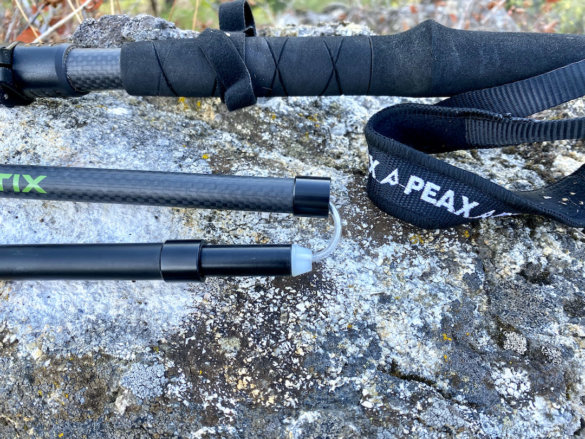
Obviously, if you’re hunting wide-open terrain, high deserts or alpine areas mostly above treeline, packability is far less important. To me, it’s critical. So in the middle of this archery elk season, I bought the PEAX Backcountry Z Sissy Stix, first and foremost because their foldable z-style packs down to just 14″.
Immediately I stopped getting hung up in brush as often. My hunting partner, who is still running with his 24″ telescoping poles, now gets noticeably hung up in heavy brush and timber more often than I do — and I’m a bigger guy.
How They Work
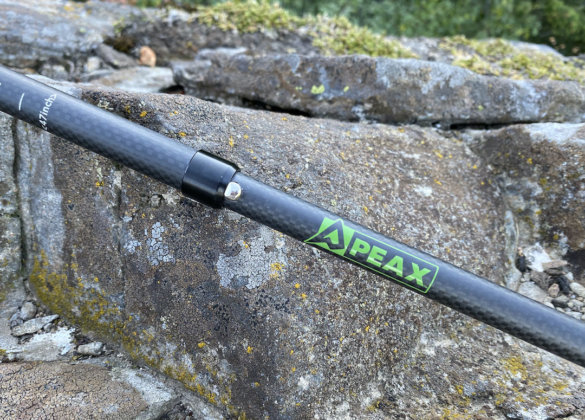
All you have to do to get a sense of the Backcountry Z is look at a photo that shows three pole sections connected together by a cord running inside of the sections. They look sort of like shock-corded tent poles. The Backcountry Z poles, on the other hand, fit together more precisely than most tent poles — and they become fully rigid so they don’t come apart when you pull them.
When I first opened up the package, I shrugged to figure out how to deploy the Backcountry Z Sissy Stix. Telescoping trekking poles are easy. Loosen a latch and extend, then tighten the latch.
With the Backcountry Z Sissy Stix, there is no obvious way to get rid of the excess cord during setup. The trick to deploying the Backcountry Z Sissy Stik is realizing that there is push button lock hidden inside the handle section of the poles. When you pull the handle up while holding the interior pole section, you’ll feel the internal cable become taught just before you extend past the push button lock.
Once you figure this out, deployment is super fast and easy.
Excellent Design Elements
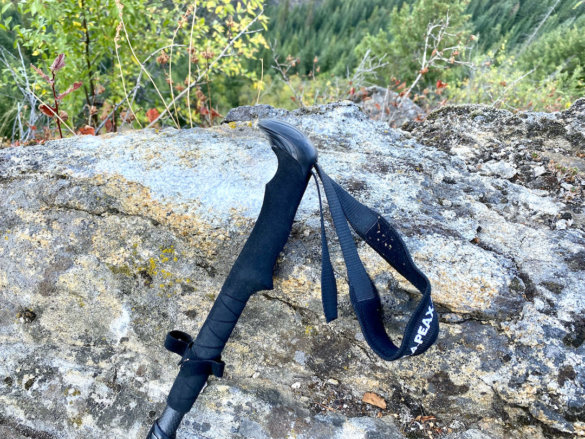
Because PEAX Equipment Company is owned and operated by big game hunters, they designed their Sissy Stix trekking poles to work well for hunters.
I particularly appreciate the handle design. It’s made from a comfortable EVA foam and it extends farther down the pole than most trekking poles. This is handy because it lets you choke up on the handle when you transition into climbing particularly steep sections. It effectively lets you climb with two different pole lengths.
In addition, the top of the handle is extra rigid and wide to let you brace your palms against it while climbing down very steep terrain.
For steep downhill sections, you can hold the poles more like long canes, which lets you brace against gravity to keep your decent slow and under control. And in case you’re wondering, trekking poles make steep downhill sections easier on your knees!
And since I brought up the subject of knees, trekking poles make particularly great gifts for hunters who want to maximize their time outdoors, despite their age or athletic wear or tear.
Shop all Sissy Stix trekking poles and accessories at PEAX and get FREE Shipping!
Carbon Fiber & Aluminum Construction
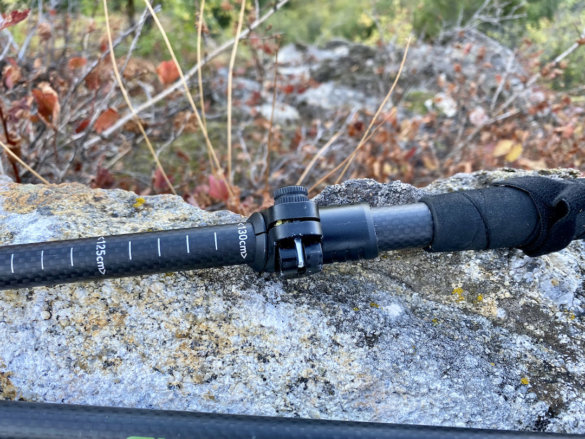
PEAX Sissy Stix use carbon fiber in the upper pole sections and aerospace 7075 aluminum in the lower section. If carbon fiber is slightly lighter than aluminum, why does PEAX use aluminum in the lowest section? If you are traversing rocky alpine terrain, your lower pole sections will take a beating on the rocks. Aluminum generally holds up better to this kind of abuse.
The two materials together let PEAX deliver a rugged stick that can handle heavy loads while also maintaining a competitive weight.
A single Backcountry Z Sissy Stix pole weighs 9 ounces (18 ounces for the pair). When it comes to trekking poles, I’m happy with any pair that comes in close to a pound.
Navigating rugged terrain in the dark? Read this first: PEAX Backcountry Duo Headlamp Review
Two Basket Options Included
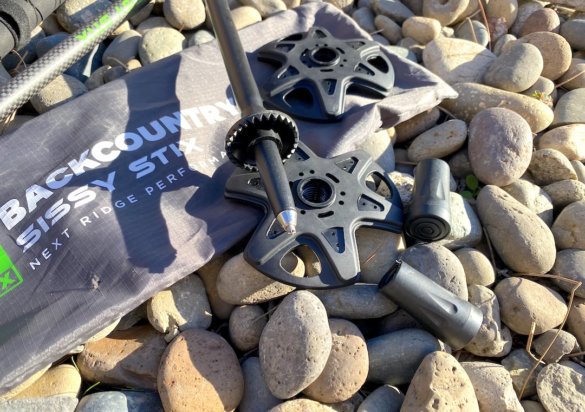
PEAX includes two basket options with the Backcountry Z trekking poles. The main basket that most hunters will use most of the time are called Trekker 2. They’re relatively small so they won’t snag on brush but they’re also wide enough to keep your pole from sinking too deep into forest floor duff or mud. I very much like the Trekker 2 baskets.
The second included baskets, the Powder Pro, is a snow basket that you can swap out in case you want to use the Sissy Stix in the winter or just get caught in a snowstorm.
Competitive Alternatives & Options
While there are many trekking pole options available these days, most trekking poles are aimed at hiking, backpacking, and mountaineering. There are fewer trekking poles designed more specifically for hunters — and particularly for hunters who might be carrying very heavy backpacks loaded with big game meat. Here are some competitive alternative trekking pole options you might also want to consider:
Black Diamond Alpine FLZ Trekking Poles — Black Diamond makes a wide variety of high-quality trekking poles. The Black Diamond FLZ Z-Poles share a similar z-style design with the Backcountry Z Sissy Stix. There are two key differences: First, the Black Diamond Alpine FLZ is made from aluminum (no carbon fiber). Second, the Alpine FLZ comes in three size options with different usable lengths — so pay attention to which length you buy. Also, if you want to use rubber tips, the Black Diamond Flex Tech Tips system is better than the pop-on rubber tips available for the Backcountry Z.
Black Ovis Crestone Collapsible Carbon Trekking Poles — The Black Ovis Crestone Collapsible Trekking Poles have carbon fiber shafts — unlike the Sissy Stix, they don’t have aluminum lower shafts. At 18 ounces per pair, they weigh the same as the Backcountry Z Sissy Stix. They are slightly less adjustable in length compared to the Sissy Stix but they cost a bit less, too.
Backcountry Elite Sissy Stix — The PEAX Backcountry Elite Sissy Stix share the same pole material usage with the Backcountry Z, but the Elite model uses a telescoping design. While the packable length of 24.5″ is longer than the Backcountry Z, the Elite Sissy Stix don’t have sections that you need to velcro together or manage in your pack. One surprising key difference is the use of screw-on rubber feet that can fit over the top of the typical tungsten carbide tips — the Backcountry Z rubber tips push on, which means they’re more prone to falling off during use. We’re not sure why the Backcountry Z Sissy Stix don’t have the same screw-on tip system, but if you plan extensive use of rubber tips, you should consider the PEAX Backcountry Elite or the Black Diamond Alpine FLZ.
Camofire Highline Aluminum Trekking Poles — If you’re looking for an affordable set of trekking poles that are rugged enough for big game hunting when you’re hauling heavy loads, the Campfire Highline Aluminum Trekking Poles blend a rugged aluminum telescoping design with extended EVA foam grips.
The Bottom Line
All-in-all, the PEAX Backcountry Z Sissy Stix Trekking Poles are an an excellent z-style trekking pole designed for hunting. Aluminum lowers help maintain durability over rugged off-trail hunts while carbon uppers help keep weight low. The EVA foam handle with the extended grip gives you another hand option for quick steep climbs. The most important benefit, though, is the super-packable 14″ collapsed length. Very highly recommended.
Get the Gear:

